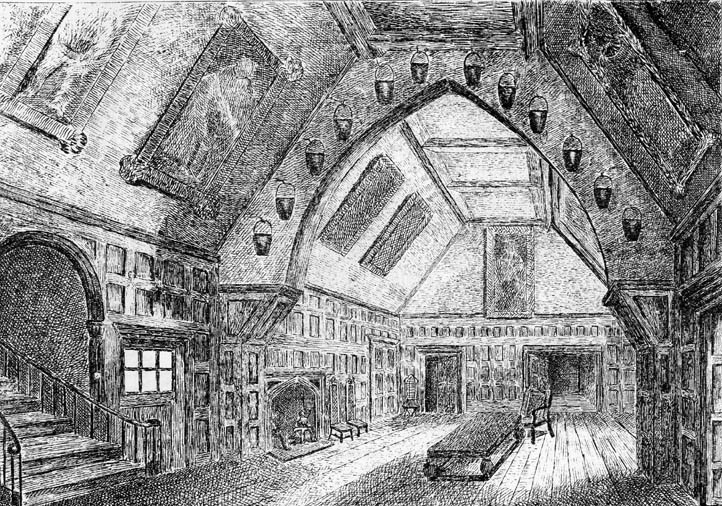
Pengethley pre fire
The Rev Thomas Powell Symonds gifted the Walker Organ to St Dubricius' in 1869. The Symonds family has had a close relationship with St Dubricius church, although Pengethley, the family home for many generations, is actually in the neighbouring parish of Sellack, where family members are buried in the parish church of St Tysilio.
In 1583 Edmund and John, sons of Richard Powell of Harewood, jointly purchased the Pengethley estate for 1000 marks. John died in 1606 and bequeathed his share of Pengethley to Edmund, from whom it desended to his son Sir Edward Powell. Edward Powell died childless, so leaving his estates to his nephew William Hinson of Pengethley, who took on the name and arms of Powell. William's only child, Mary, inherited the estates, and married Sir John Williams of Elham, in Thanet, Kent. The Symonds would continue to have associations with the Isle of Thanet for generations.
Robert Symonds of Sugwas was appointed Sheriff of Herefordshire by William III in 1701. In 1713 Robert's son Thomas Symonds MD, married Penelope, daughter of Sir John Williams and Mary Powell.
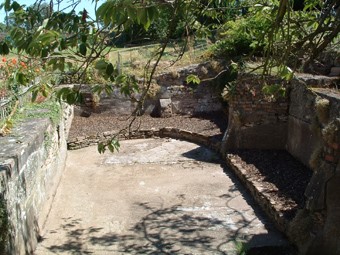
the Pengethley cellars now
In the late 18th century Robert's great-grandson Thomas Powell Symonds (1788-1819) inherited the Pengethley estate.
On 15 October 1800 the Hereford Journal reported that 'Thomas Powell Symonds, Esq, Pengethley, has offered himself a Candidate for the vacancy the representation of this city, occasioned by the death Mr. Walwyn, and there is no appearance of any opposition'. So Thomas Powell Symonds was elected unopposed to be one of the two MPs for the City of Hereford. Like his predecessor James Walwyn, Symonds enjoyed the patronage of the 11th Duke of Norfolk, married to the mad Frances Scudamore (1750–1820) confined to her family home at Holme Lacy House six miles to the north of Pengethley.
When Symonds first entered the Commons in November 1800 the Prime Minister was William Pitt the younger. It was the last Parliament of Great Britain. The Acts of Union 1800 came into force on 1st January 1801, and the merged Parliament of the United Kingdom of Great Britain and Ireland met for the first time on 22nd January 1801. The defeat of the Austrians at the Battles of Marengo and Hohenlinden had left Britain facing Revolutionary France alone.
Unable to dissuade the king from opposing Catholic Emancipation, Pitt resigned on 16th February 1801, in order for his ally Henry Addington to form a new government, although the King's madness prevented power being transferred from Pitt to Addingtom until 14th March.
In July 1801 Thomas married a young woman, surnamed Rootes, from Elham, about whom very little is known. The couple had only been married for a couple of months when, on 6th September, Thomas's younger brother, Rev Joseph Powell Symonds died. Thomas became guardian to Joseph's children, Penelope, 12; Sarah 14; Thomas Powell Symonds 12; and Mary Powell 9.
Mary caused a scandal when, aged 20, she eloped with her uncle's Welsh groom, Evan Thomas, whom she married, under the name of Mary Powell, at St Mary’s Church, Aberavon,on 6 Oct 1812. Mary became a famer's wife in the village of Baglan, Glamorganshire, where the couple raised eight children. In 1879 her grandson, Robert Taylor, would serve as in the Zulu Wars as a private soldier in the South Wales Borderers; quite removed from the militia majors and colonels of the original Herefordshire family. Mary's older sisters Penelope and Sarah made more conventional and respectable marriages.
These were certainly interesting times to be a new MP. The French Revolutionary Wars were ended in 1802 by the Treaty of Amiens between France and Britain. But in 1803, war began again with France, now under Emperor Napoleon. Symonds had been a member of the Whig Club since 1788. The Whig programme included the supremacy of parliament, free trade, Catholic emancipation, the abolition of slavery, and expansion of the franchise.
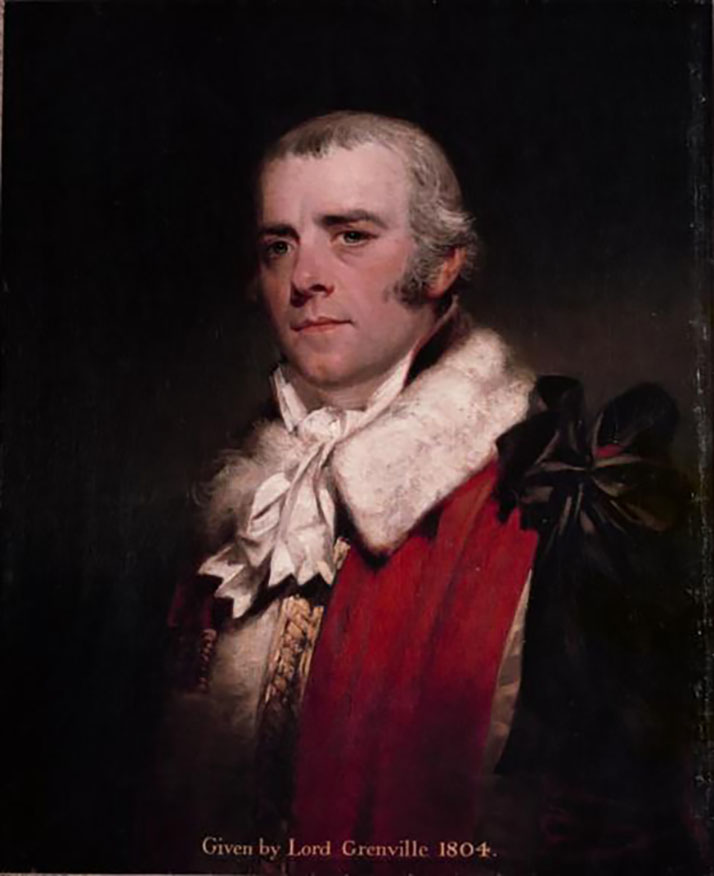
William Grenville
Symonds supported the ministry of William Grenville, Prime Minister 11 February 1806 to 25 March 1807. He voted for their repeal of Pitt’s Additional Force Act, which had been passed in order to add 15,780 men to the army for the defence of England against a threatened Napoleonic invasion.
In 1808, his sponsor, The Duke Norfolk, in his capacity as hereditary Earl Marshal, appointed Symonds Registrar of the College of Arms. The Registrar is charged with the duty of keeping the Official Roll and making all necessary entries and deletions. As far as 'networking' went, the unobrusive position could hardly be bettered.
He voted for the Whig motions against abuses and ministerial corruption, and against the militia completion bill. He voted for parliamentary reform, 21 May 1810, and was listed as a steward for the abortive constitutional reform meeting of 10 June 1811.
On Saturday 15th July 1815, Mrs Symonds sustained serious injuries when the carriage in which she was travelling overturned near the Callow, ten miles north of Pengethley. She died on 23rd July 1815, without ever regaining consciousness. In 1835 this dangerous stretch of road was replaced by a new route, although even this has continued to be the scene of numerous accidents into the 21st century. Four years later, on 19th August 1819 Thomas Powell Symonds also died. He was buried at Sellack on 24 August, aged 57. The couple were childless, and Thomas's nephew, also Thomas Powell Symonds, inherited the Pengethley estate.
Thomas Powell Symonds MP had been the eldest son of another Thomas Powell Symonds (1719 -1793); The Rev Joseph Powell Symonds, the late father of the MPs young wards, had been the second son. Politics and the church were the expected pursuits of the contemporary landed gentry.
Joseph had been born in 1764, and appears to have been the first Symonds to enter the church. He matriculated to St Johns, Oxford in March 1781. Joseph was ordained deacon in 1786 and became curate at Foy. Foy is the parish immediately to the east of Sellack. In 1787 he became Vicar of Dymock. Dymock is in the Forest of Dean and just south of Pengethley. Four of his children - Sarah, Thomas Powell, Mary and Mary Powell - were born at Dymock, but the eldest, Penelope, had been born at Bridstow near Ross in 1786, before he received the Dymock living. Mary had been born in 1790 and died the same year. The daughter born the following year, she who was to elope with her uncle's groom, was named Mary Powell Symonds.
On 12 March 1800 Rev Joseph Powell Symonds was installed as rector of Dinedor, another Hereford Parish. This is where he died on 6th September 1801. Robert, the fourth son, born in 1768, also joined the church, being appointed Rector of Hinton in Berkshire in 1806, and dying there in 1836.
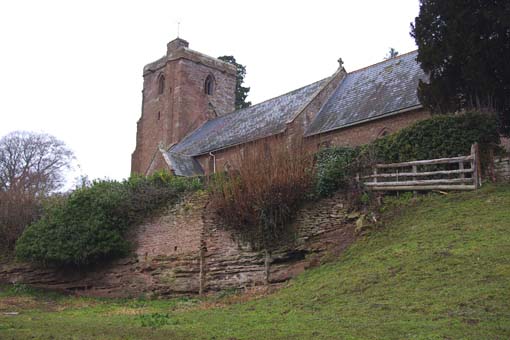
St Mary's Church, Foy
Joseph's son Thomas Powell Symonds was brought up in Pengethley with his sisters. In 1813 he received his MA from Cambridge, was ordained priest, and became a curate at Foy, as his late father had been. The Rev Thomas Powell Symonds was the great-great-grandson of Robert Symonds.
In 1818 The Rev Symonds was appointed to a curacy in the parish of Monkton with Birchington in Kent. He was registered in that parish when he married Elizabeth Turner at Mary-le-bone, Middlesex, on 18th April 1816. Thomas and Elizabeth's two sons, Thomas Powell Symonds and William Turville Symonds were born during Thomas and Elizabeth's time at Monkton. In 1818 the Rev Symonds became a royal chaplain to Prince Augustus Frederick, Duke of Sussex, the sixth son and ninth child of King George III.
The royal chaplaincy appears to have been the apogee of Rev Symonds clerical career. In May 1827 he became a curate at Llandinabo, a parish to the west of Pengethley. Afterwards he occupied himself with his estate and local pursuits. He rebuilt Pengethley House after it suffered a catastrophic fire. Although in holy orders, in both the 1851 and 1861 censuses he is listed as 'Clergyman not having care of Souls'.
Prince Augustus (1773 - 1843) was one of the most liberal members of the royal family. He was in favour of reform of Parliament, abolition of the slave trade, Catholic emancipation, and the removal of restrictions on Jews and dissenters.
At Pengethley the Rev Symonds was a Victorian county gentleman and magistrate although of course he remained an ordained priest, occasionally functioning as one, as when, on Nov 2nd 1843 at Peterstow, he conducted the marriage of William Williams, of Agincourt-square, Monmouth, to Caroline, youngest daughter of Mr. Addis, of Whitfield, Peterstow.
As his association with the progressive prince might suggest, he did not lack charitable impulse. In September 1849 he voluntarily reduced the rents of all his tenants in response to the economic difficulties of the times and the cholera outbreak (52,000 people died in the two-year outbreak which began in England and Wales in 1848). It was he who, in 1869, donated the Walker organ to St Dubricius Church.
Serving in the Militia was normal practice for the gentry and the younger Thomas Powell Symonds, the son of the reverend, was a Major in the local militia. The rank was always used for formal announcements, as in the newspaper marriage notice that 'Major Thomas Powell Symonds, Herefordshire Militia, only son of the Rev Thomas Powell Symonds of Pengethley to Anna, third daughter of the Rev. Peter Cotes, rector of Litchfield.' The Rev Cotes was rector of Litchfield, Southampton where Anna and her sisters were raised. In October 1862 Major Symonds was promoted to Lieutenant Colonel.
The marriage seems not to have been a happy. The disparity in their ages may not have helped - He was 44 and she was 23. In 1870 Colonel Symonds began divorce proceedings against his wife on the grounds of her adultery with Broadley Harrison (Symonds v Symonds and Harrison 15th September 1870). In the 1861 Census Broadley Harrison had been listed as an 'Irish colonel on half pay'. Aged 39 and married; he and his wife and children lived at Withington, a Herefordshire village. By 1871 he was a neighbour of the Symonds. Described as a 'Colonel in the Army' in the census, he and his wife were resident at Kynaston House 700 metres north of St Dubricius Church, one and a half kilometres - less than a mile - north of Pengethley.
On census night, 2 April 1871, three-year-old Caroline was at Pengethley with her father. Anna was living in the rectory at Newington, Oxfordshire, where her uncle Septimus Coates was rector. She is described as 'married'.
The case was heard before the Right Honourable James Plaisted Baron Penzance, Judge of her Majesty's Court of Probate and Judge Ordinary for Divorce and Matrimonial Causes sitting in open Court at Westminster.
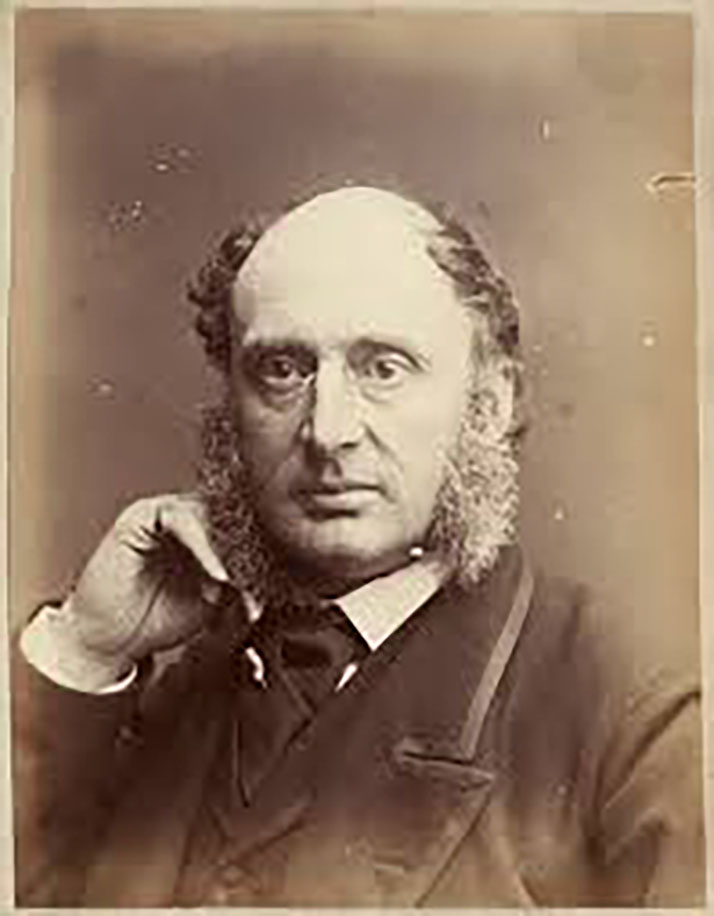
Judge Lord Penzance
Presented in support of the petition was an affidavit by Elizabeth Symonds, widow of Rev Thomas Powell Symonds and mother of Thomas Powell Symonds junior, the petitioner. Other affidavits were by Comfort Philpotts, the wife of a local tailor and shopkeeper John Philpotts, and John Gwynne James, a local solicitor. In a further humiliation Anna was ordered to produce the dairies she had kept since her marriage. A decree nisi was obtained 21st July 1871.
That these events were acrimonious, and accompanied by drama and distress is demonstrated by a report in the Police Gazette of Monday October 30 1871 -
Whereas a child (girl) 6 years of age, very fair, light blue eyes, flaxen hair, named CAROLINE ELIZABETH SYMONDS usually called LINA was taken away from Gloucester in the 18th Instant by Anna Symonds, her mother, about 5 feet high, fair, light brown hair, hazel eyes, about 20 years of age, and who is supposed to have been accompanied by another female, and to have traveled by rail from Stonehouse to Paddington and to have arrived at the latter station at 5 pm, and has not since been heard of.
And whereas such abduction was a contempt of Her Majesty’s Court for Divorce and an attachment issued against said Anna Symonds. Whoever will give such information as shall lead to the recovery of the said child shall receive £25; and whoever shall will give such information as shall lead to the arrest of the said Anna Symonds shall receive £10 reward.
The decree absolute is dated 30th January 1872. Thomas Powell Symonds died 28 Nov 1876.
In 1881 Anna and Caroline were living in Bath. Anna was by now described as a 'widow'. Caroline had a German governess, Sophia Kessler from Frankfurt.
In 1891 Anna and Caroline were back at Pengethley. Caroline, now 25 and 'living on her own means' was the head of the household, and Anna was a widow of 52, also 'living on her own means'.
Whether the difficulties of her parent's marriage affected her deeply or not, Caroline Symonds never married. The Pengethley property, for which she probably had little fondness, was sold, and later converted into a hotel. Caroline Symonds died in Oxford in March 1947.
The Miss Caroline E. Symonds Garden in Ross-on-Wye is named for her.
Robin Symonds, The project leader of St Dubricius church restoration project, is a direct descendent (8 generations) of Robert Symonds of Sugwas.